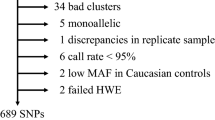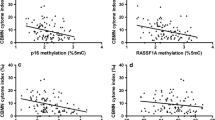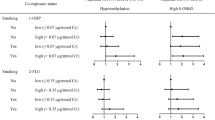Abstract
Polycyclic aromatic hydrocarbon (PAH) exposure and genetic susceptibility were conductive to genotoxic effects including gene damage, which can increase mutational probability. We aimed to explore the dose-effect associations of PAH exposure with damage of exons of epidermal growth factor receptor (EGFR) and breast cancer susceptibility gene 1 (BRCA1), as well as their associations whether modified by Flap endonuclease 1 (FEN1) genotype. Two hundred eighty-eight coke oven male workers were recruited, and we detected the concentration of 1-hydroxypyrene (1-OH-pyr) as PAH exposure biomarker in urine and examined base modification in exons of EGFR and BRCA1 respectively, and genotyped FEN1 rs174538 polymorphism in plasma. We found that the damage indexes of exon 19 and 21 of EGFR (EGFR-19 and EGFR-21) were both significantly associated with increased urinary 1-OH-pyr (both Ptrend < 0.001). The levels of urinary 1-OH-pyr were both significantly associated with increased EGFR-19 and EGFR-21 in both smokers and nonsmokers (both P < 0.001). Additionally, we observed that the urinary 1-OH-pyr concentrations were linearly associated with both EGFR-19 and EGFR-21 only in rs174538 GA+AA genotype carriers (both P < 0.001). Moreover, FEN1rs rs174538 showed modifying effects on the associations of urinary 1-OH-pyr with EGFR-19 and EGFR-21 (both Pinteraction < 0.05). Our findings revealed the linear dose-effect association between exon damage of EGFR and PAH exposure and highlight differences in genetic contributions to exon damage and have the potential to identify at-risk subpopulations who are susceptible to adverse health effects induced by PAH exposure.





Similar content being viewed by others
Data availability
All data generated or analyzed during this study are included in this published article (and its supplementary information files).
References
Anandi Srinivasan H-JL, Larry W. R, Gabriele L (2001) Production of DNA strand breaks in vitro and reactive oxygen species in vitro and in HL-60 cells by PCB metabolites. Toxicol Sci 69:92–102
Armstrong B, Hutchinson E, Unwin J, Fletcher T (2004) Lung cancer risk after exposure to polycyclic aromatic hydrocarbons: a review and meta-analysis. Environ Health Perspect 112:970–978. https://doi.org/10.1289/ehp.6895
Bin P, Leng S, Cheng J, Dai Y, Huang C, Pan Z, Niu Y, Duan H, Li H, Liu Q, Chen W, Zheng Y (2008) Association of aryl hydrocarbon receptor gene polymorphisms and urinary 1-hydroxypyrene in polycyclic aromatic hydrocarbon-exposed workers. Cancer Epidemiol Biomark Prev 17:1702–1708. https://doi.org/10.1158/1055-9965.EPI-07-2812
Bircan S, Baloglu H, Kucukodaci Z, Bircan A (2014) EGFR and KRAS mutations in Turkish non-small cell lung cancer patients: a pilot study. Med Oncol 31:87. https://doi.org/10.1007/s12032-014-0087-4
Cheng YI, Gan YC, Liu D, Davies MPA, Li WM, Field JK (2019) Potential genetic modifiers for somatic EGFR mutation in lung cancer: a meta-analysis and literature review. BMC Cancer 19:1068. https://doi.org/10.1186/s12885-019-6317-6
da Cunha SG, Shepherd FA, Tsao MS (2011) EGFR mutations and lung cancer. Annu Rev Pathol 6:49–69. https://doi.org/10.1146/annurev-pathol-011110-130206
Ewa B, Danuta MS (2017) Polycyclic aromatic hydrocarbons and PAH-related DNA adducts. J Appl Genet 58:321–330. https://doi.org/10.1007/s13353-016-0380-3
Gedik CM, Boyle SP, Wood SG, Vaughan NJ, Collins AR (2002) Oxidative stress in humans: validation of biomarkers of DNA damage. Carcinogenesis 23:1441–1446. https://doi.org/10.1093/carcin/23.9.1441
Han X, Liang WL, Zhang Y, Sun LD, Liang WY (2016) Effect of atmospheric fine particles on epidermal growth factor receptor mRNA expression in mouse skin tissue. Genet Mol Res 15. https://doi.org/10.4238/gmr.15017188
He L, Luo L, Zhu H, Yang H, Zhang Y, Wu H, Sun H, Jiang F, Kathera CS, Liu L, Zhuang Z, Chen H, Pan F, Hu Z, Zhang J, Guo Z (2017) FEN1 promotes tumor progression and confers cisplatin resistance in non-small-cell lung cancer. Mol Oncol 11:640–654. https://doi.org/10.1002/1878-0261.12058
Hosgood HD 3rd, Pao W, Rothman N, Hu W, Pan YH, Kuchinsky K, Jones KD, Xu J, Vermeulen R, Simko J, Lan Q (2013) Driver mutations among never smoking female lung cancer tissues in China identify unique EGFR and KRAS mutation pattern associated with household coal burning. Respir Med 107:1755–1762. https://doi.org/10.1016/j.rmed.2013.08.018
Huang CY, Hsieh MJ, Wu WJ, Chiang WL, Liu TC, Yang SF, Tsao TC (2018) Association of endothelial nitric oxide synthase (eNOS) polymorphisms with EGFR-mutated lung adenocarcinoma in Taiwan. J Cancer 9:2518–2524. https://doi.org/10.7150/jca.25824
Jeng HA, Pan CH, Chao MR (2013) 1-Hydroxypyrene as a biomarker for assessing the effects of exposure to polycyclic aromatic hydrocarbons on semen quality and sperm DNA integrity. J Environ Sci Health A Tox Hazard Subst Environ Eng 48:152–158. https://doi.org/10.1080/03601234.2012.716741
Jin Y, Wu W, Zhang W, Zhao Y, Wu Y, Ge G, Ba Y, Guo Q, Gao T, Chi X, Hao H, Wang J, Feng F (2017) Involvement of EGF receptor signaling and NLRP12 inflammasome in fine particulate matter-induced lung inflammation in mice. Environ Toxicol 32:1121–1134. https://doi.org/10.1002/tox.22308
Jongeneelen FJ (2001) Benchmark guideline for urinary 1-hydroxypyrene as biomarker of occupational exposure to polycyclic aromatic hydrocarbons. Ann Occup Hyg 45:3–13
Kim HJ, Jang CH (2018) Imaging DNA single-strand breaks generated by reactive oxygen species using a liquid crystal-based sensor. Anal Biochem 556:1–6. https://doi.org/10.1016/j.ab.2018.06.009
Krawczyk P, Reszka K, Ramlau R, Powrózek T, Pankowski J, Wojas-Krawczyk K, Kalinka-Warzocha E, Szczęsna A, Nicoś M, Jarosz B, Szyszka-Barth K, Bryl M, Adamowicz K, Szumiło J, Milanowski J (2016) Prevalence of rare EGFR gene mutations in nonsmall-cell lung cancer: a multicenter study on 3856 Polish Caucasian patients. Ann Oncol 27:358–359. https://doi.org/10.1093/annonc/mdv553
Kuang D, Zhang W, Deng Q, Zhang X, Huang K, Guan L, Hu D, Wu T, Guo H (2013) Dose-response relationships of polycyclic aromatic hydrocarbons exposure and oxidative damage to DNA and lipid in coke oven workers. Environ Sci Technol 47:7446–7456. https://doi.org/10.1021/es401639x
Lin CH, Yang PJ, Lin SH, Yeh KT, Tsao TC, Chen YE, Lin SH, Yang SF (2020) Association between EGFR gene mutation and antioxidant gene polymorphism of non-small-cell lung cancer. Diagnostics (Basel) 10. https://doi.org/10.3390/diagnostics10090692
Liu L, Zhou C, Zhou L, Peng L, Li D, Zhang X, Zhou M, Kuang P, Yuan Q, Song X, Yang M (2012) Functional FEN1 genetic variants contribute to risk of hepatocellular carcinoma, esophageal cancer, gastric cancer and colorectal cancer. Carcinogenesis 33:119–123. https://doi.org/10.1093/carcin/bgr250
McClean MD, Osborn LV, Snawder JE, Olsen LD, Kriech AJ, Sjodin A, Li Z, Smith JP, Sammons DL, Herrick RF, Cavallari JM (2012) Using urinary biomarkers of polycyclic aromatic compound exposure to guide exposure-reduction strategies among asphalt paving workers. Ann Occup Hyg 56:1013–1024. https://doi.org/10.1093/annhyg/mes058
Moazeni-Roodi A, Ghavami S, Ansari H, Hashemi M (2019) Association between the flap endonuclease 1 gene polymorphisms and cancer susceptibility: an updated meta-analysis. J Cell Biochem 120:13583–13597. https://doi.org/10.1002/jcb.28633
Moorthy B, Chu C, Carlin DJ (2015) Polycyclic aromatic hydrocarbons: from metabolism to lung cancer. Toxicol Sci 145:5–15. https://doi.org/10.1093/toxsci/kfv040
Nisha AR, Hazilawati H, Mohd Azmi ML, Noordin MM (2017) DNA damage and adduct formation in immune organs of developing chicks by polycyclic aromatic hydrocarbons. Toxicol Mech Methods 27:215–222. https://doi.org/10.1080/15376516.2016.1273432
Perez-Ramirez C, Canadas-Garre M, Molina MA, Cabeza Barrera J, Faus-Dader MJ (2019) Impact of single nucleotide polymorphisms on the efficacy and toxicity of EGFR tyrosine kinase inhibitors in advanced non-small cell lung cancer patients. Mutat Res 781:63–70. https://doi.org/10.1016/j.mrrev.2019.04.001
Pratt MM, John K, MacLean AB, Afework S, Phillips DH, Poirier MC (2011) Polycyclic aromatic hydrocarbon (PAH) exposure and DNA adduct semi-quantitation in archived human tissues. Int J Environ Res Public Health 8:2675–2691. https://doi.org/10.3390/ijerph8072675
Ren H, Ma H, Ke Y, Ma X, Xu D, Lin S, Wang X, Dai ZJ (2015) Flap endonuclease 1 polymorphisms (rs174538 and rs4246215) contribute to an increased cancer risk: evidence from a meta-analysis. Mol Clin Oncol 3:1347–1352. https://doi.org/10.3892/mco.2015.617
Rezaei M, Hashemi M, Sanaei S, Mashhadi MA, Hashemi SM, Bahari G, Taheri M (2016) FEN1 -69G>A and +4150G>T polymorphisms and breast cancer risk. Biomed Rep 5:455–460. https://doi.org/10.3892/br.2016.738
Samanta SK, Singh OV, Jain RK (2002) Polycyclic aromatic hydrocarbons: environmental pollution and bioremediation. Trends Biotechnol 20:243–248. https://doi.org/10.1016/s0167-7799(02)01943-1
Scalise JR, Pocas RC, Caneloi TP, Lopes CO, Kanno DT, Marques MG, Valdivia JC, Maximo FR, Pereira JA, Ribeiro ML, Priolli DG (2016) DNA damage is a potential marker for TP53 mutation in colorectal carcinogenesis. J Gastrointest Cancer 47:409–416. https://doi.org/10.1007/s12029-016-9846-0
Seow WJ, Matsuo K, Hsiung CA, Shiraishi K, Song M, Kim HN, Wong MP, Hong YC, Hosgood HD III, Wang Z, Chang IS, Wang JC, Chatterjee N, Tucker M, Wei H, Mitsudomi T, Zheng W, Kim JH, Zhou B, Caporaso NE, Albanes D, Shin MH, Chung LP, An SJ, Wang P, Zheng H, Yatabe Y, Zhang XC, Kim YT, Shu XO, Kim YC, Bassig BA, Chang J, Ho JCM, Ji BT, Kubo M, Daigo Y, Ito H, Momozawa Y, Ashikawa K, Kamatani Y, Honda T, Sakamoto H, Kunitoh H, Tsuta K, Watanabe SI, Nokihara H, Miyagi Y, Nakayama H, Matsumoto S, Tsuboi M, Goto K, Yin Z, Shi J, Takahashi A, Goto A, Minamiya Y, Shimizu K, Tanaka K, Wu T, Wei F, Wong JYY, Matsuda F, Su J, Kim YH, Oh IJ, Song F, Lee VHF, Su WC, Chen YM, Chang GC, Chen KY, Huang MS, Yang PC, Lin HC, Xiang YB, Seow A, Park JY, Kweon SS, Chen CJ, Li H, Gao YT, Wu C, Qian B, Lu D, Liu J, Jeon HS, Hsiao CF, Sung JS, Tsai YH, Jung YJ, Guo H, Hu Z, Wang WC, Chung CC, Lawrence C, Burdett L, Yeager M, Jacobs KB, Hutchinson A, Berndt SI, He X, Wu W, Wang J, Li Y, Choi JE, Park KH, Sung SW, Liu L, Kang CH, Hu L, Chen CH, Yang TY, Xu J, Guan P, Tan W, Wang CL, Sihoe ADL, Chen Y, Choi YY, Hung JY, Kim JS, Yoon HI, Cai Q, Lin CC, Park IK, Xu P, Dong J, Kim C, He Q, Perng RP, Chen CY, Vermeulen R, Wu J, Lim WY, Chen KC, Chan JKC, Chu M, Li YJ, Li J, Chen H, Yu CJ, Jin L, Lo YL, Chen YH, Fraumeni JF Jr, Liu J, Yamaji T, Yang Y, Hicks B, Wyatt K, Li SA, Dai J, Ma H, Jin G, Song B, Wang Z, Cheng S, Li X, Ren Y, Cui P, Iwasaki M, Shimazu T, Tsugane S, Zhu J, Jiang G, Fei K, Wu G, Chien LH, Chen HL, Su YC, Tsai FY, Chen YS, Yu J, Stevens VL, Laird-Offringa IA, Marconett CN, Lin D, Chen K, Wu YL, Landi MT, Shen H, Rothman N, Kohno T, Chanock SJ, Lan Q (2017) Association between GWAS-identified lung adenocarcinoma susceptibility loci and EGFR mutations in never-smoking Asian women, and comparison with findings from Western populations. Hum Mol Genet 26:454–465. https://doi.org/10.1093/hmg/ddw414
Sigismund S, Avanzato D, Lanzetti L (2018) Emerging functions of the EGFR in cancer. Mol Oncol 12:3–20. https://doi.org/10.1002/1878-0261.12155
Sobus JR, McClean MD, Herrick RF, Waidyanatha S, Nylander-French LA, Kupper LL, Rappaport SM (2009) Comparing urinary biomarkers of airborne and dermal exposure to polycyclic aromatic compounds in asphalt-exposed workers. Ann Occup Hyg 53:561–571. https://doi.org/10.1093/annhyg/mep042
Soo RA, Kubo A, Ando M, Kawaguchi T, Ahn MJ, Ou SI (2017) Association between environmental tobacco smoke exposure and the occurrence of EGFR mutations and ALK rearrangements in never-smokers with non-small-cell lung cancer: analyses from a prospective multinational ETS registry. Clin Lung Cancer 18:535–542. https://doi.org/10.1016/j.cllc.2017.01.005
Wen W, Che W, Lu L, Yang J, Gao X, Wen J, Heng Z, Cao S, Cheng H (2008) Increased damage of exon 5 of p53 gene in workers from an arsenic plant. Mutat Res 643:36–40. https://doi.org/10.1016/j.mrfmmm.2008.06.005
Winther-Larsen A, Fynboe Ebert EB, Meldgaard P, Sorensen BS (2019) EGFR gene polymorphism predicts improved outcome in patients with EGFR mutation-positive non-small cell lung cancer treated with erlotinib. Clin Lung Cancer 20:161–166 e1. https://doi.org/10.1016/j.cllc.2019.02.011
Yamano Y, Hara K, Ichiba M, Hanaoka T, Pan G, Nakadate T (2014) Urinary 1-hydroxypyrene as a comprehensive carcinogenic biomarker of exposure to polycyclic aromatic hydrocarbons: a cross-sectional study of coke oven workers in China. Int Arch Occup Environ Health 87:705–713. https://doi.org/10.1007/s00420-013-0913-6
Yanagawa N, Tamura G, Oizumi H, Endoh M, Sadahiro M, Motoyama T (2011) Inverse correlation between EGFR mutation and FHIT, RASSF1A and RUNX3 methylation in lung adenocarcinoma: relation with smoking status. Anticancer Res 31:1211–1214
Yang M, Guo H, Wu C, He Y, Yu D, Zhou L, Wang F, Xu J, Tan W, Wang G, Shen B, Yuan J, Wu T, Lin D (2009) Functional FEN1 polymorphisms are associated with DNA damage levels and lung cancer risk. Hum Mutat 30:1320–1328. https://doi.org/10.1002/humu.21060
Yang B, Deng Q, Zhang W, Feng Y, Dai X, Feng W, He X, Huang S, Zhang X, Li X, Lin D, He M, Guo H, Sun H, Yuan J, Lu J, Hu FB, Zhang X, Wu T (2016) Exposure to polycyclic aromatic hydrocarbons, plasma cytokines, and heart rate variability. Sci Rep 6:19272. https://doi.org/10.1038/srep19272
Ying N, Wang S, Xu H, Wang Y (2015) Association between FEN1 polymorphisms -69G>A and 4150G>T with susceptibility in human disease: a meta-analysis. Iran J Public Health 44:1574–1579
Zhang J, Ichiba M, Hara K, Zhang S, Hanaoka T, Pan G, Yamano Y, Takahashi K, Tomokuni K (2001) Urinary 1-hydroxypyrene in coke oven workers relative to exposure, alcohol consumption, and metabolic enzymes. Occup Environ Med 58:716–721. https://doi.org/10.1136/oem.58.11.716
Zhang W, Yi X, Guo S, Shi Q, Wei C, Li X, Gao L, Wang G, Gao T, Wang L, Li C (2014) A single-nucleotide polymorphism of miR-146a and psoriasis: an association and functional study. J Cell Mol Med 18:2225–2234. https://doi.org/10.1111/jcmm.12359
Zhang L, Li J, Hu J, Li D, Wang X, Zhang R, Zhang H, Shi M, Chen H (2017) Cigarette smoke extract induces EGFR-TKI resistance via promoting EGFR signaling pathway and ROS generation in NSCLC cell lines. Lung Cancer 109:109–116. https://doi.org/10.1016/j.lungcan.2017.05.011
Zhang K, Keymeulen S, Nelson R, Tong TR, Yuan YC, Yun X, Liu Z, Lopez J, Raz DJ, Kim JY (2018) Overexpression of flap endonuclease 1 correlates with enhanced proliferation and poor prognosis of non-small-cell lung cancer. Am J Pathol 188:242–251. https://doi.org/10.1016/j.ajpath.2017.09.011
Funding
This study was supported by the Natural Science Foundation of Guangdong Province (grant number 2018A030313606) and by the National Natural Science Foundation of China (grant numbers 81903381, 81803189, and 81860572), and Guangzhou Key Laboratory Fund (201905010004).
Author information
Authors and Affiliations
Contributions
We thank all individuals who volunteered to participate in this study. M.Y., Q.H., J.T., Y.H., and S.C. collected the samples and established the database and conducted the experiments. M.Y, Y.Z., and Y.B. designed and carried out the study. S.C., Y.H., and B.Y. conducted the data analysis and drafted the manuscript. Y.B. revised the manuscript. All the authors had access to the data and reviewed and approved the final submitted manuscript.
Corresponding author
Ethics declarations
Ethics approval and consent to participate
The study was approved by the Ethics Committee of Kunming Medical University.
Consent for publication
Not applicable.
Conflict of interest
The authors declare no competing interests.
Additional information
Responsible Editor: Lotfi Aleya
Publisher’s note
Springer Nature remains neutral with regard to jurisdictional claims in published maps and institutional affiliations.
Supplementary Information
ESM 1
(DOC 31 kb)
Rights and permissions
About this article
Cite this article
Chen, S., He, Y., Yan, M. et al. The interaction effects of FEN1 rs174538 polymorphism and polycyclic aromatic hydrocarbon exposure on damage in exon 19 and 21 of EGFR gene in coke oven workers. Environ Sci Pollut Res 28, 60692–60703 (2021). https://doi.org/10.1007/s11356-021-15013-y
Received:
Accepted:
Published:
Issue Date:
DOI: https://doi.org/10.1007/s11356-021-15013-y




